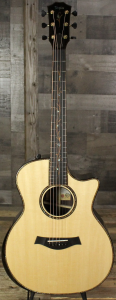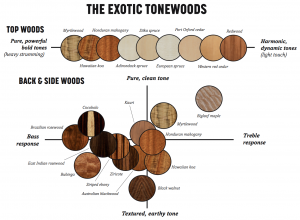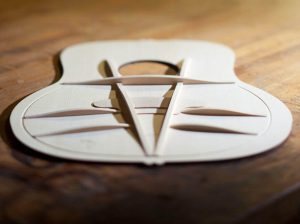Picking Your Next Guitar – Tone, Response & Body (Part 1 of 3)
Picking Your Next Guitar – Choosing Woods (Part 2 of 3)
Picking Your Next Guitar – Body Size & Playing Style (Part 3 of 3)
My biggest challenge was to find a guitar with the sound I wanted. When I started, I would explain the type of sound I wanted was louder and bass-ier. As I played with the guitars at multiple stores, I realized I preferred a guitar that was brighter, louder, and more resonant.
In this article, I am sharing how I came to trust my ear, and look at other aspects of selecting the guitar – Tone, Frequency response, and Body Style & Construction. Before we talk about how to select a guitar, let us understand each of these aspects.
about how to select a guitar, let us understand each of these aspects.
Tone
The first thing you should think about when choosing an acoustic guitar is the tone. When we talk about tone, we’re referring to the overall sound of the guitar. Different woods produce different tones, so it’s important to pick a guitar that has the right tone for your style of music. For example, if you want to play country music, you might want an acoustic guitar with a brighter, twangier sound. Or, if you’re into folk music, you might prefer a mellower tone. There are lots of ways to test out an acoustic guitar’s tone before you buy it. You can listen to audio samples online, or even better, go into a store and play the guitars yourself. Pay attention to how each one sounds and see which one feels right for you.
Frequency Response
Another important factor to consider when choosing an acoustic guitar is frequency response. Frequency response is basically how well a guitar can reproduce different frequencies of sound. Some frequencies are going to be more important for your style of music than others. For example, if you play a lot of chords, you’ll want a guitar with a good low-frequency response so that all of the notes in your chords sound clear and distinct. On the other hand, if you do a lot of lead playing with single-note melodies, you might want a guitar with a good high-frequency response so that your notes have a nice “sparkle” to them.
Once again, the best way to figure out whether an acoustic guitar has a good frequency response is to either listen to audio samples or go into a store and play the guitar yourself. Listen for things like clarity and balance across all frequencies—you should be able to hear all of the notes clearly without any one frequency being too overpowering.
Here is a great example of Breedlove Guitars infographic on tone and frequency response for various kinds of wood.
Body Style and Construction
Besides the tone and frequency response body style & construction play a very important role. Acoustic guitars come in a variety of shapes and sizes, from small parlor-style guitars to large-bodied jumbos (or Dreadnaughts). The type of body you choose will have a major impact on the instrument’s sound. For example, smaller-bodied guitars tend to have a tighter, more focused sound, while larger-bodied guitars have a richer, more resonant sound. The size of the sound chamber (part of the body size & construction) affects your playability. You’ll want to make sure that the acoustic guitar you choose is comfortable and easy to play. A large-bodied Dreadnaught guitar would have you reach out for strumming and may not be comfortable for long playing sessions. A guitar with a low action (the distance between the strings and the fretboard) and smooth, comfortable fretboard edges will also add to the playability. Do you need a narrow or wide neck; typically, beginner players do better with narrower necks since they’re easier to maneuver around; at the same time if you have larger hands, then consider a wider neck.
A great example is Taylor’s V-Class Bracing which helps make the guitar louder, and sustains the notes longer, with better intonation of each.
Another aspect of construction is the different materials used in construction – laminate, highly compressed laminate, carbon fiber, and real wood. Other than real wood, man-made materials are easier to maintain and do not get affected by temperature and humidity. Real wood requires more caring, and, in my humble opinion, also sounds better. Man-made materials are generally budget-friendly (except for some exotic carbon fiber guitars). Real wood guitars can be expensive; even higher if there are no joints in the body.
How to pick your next guitar
- Avoid boxed guitars from departmental stores or online stores. You do not know what you will get. It’s a gamble.
- Set some time aside to visit local stores and play the guitars. Go visit the local guitar stores, and play the guitars, even if you do not know how to play the guitar, just strum the strings and hear how the guitar sounds. Your ear is going to be the best judge of what you want.
- Have a budget. You can buy a guitar from $50 to $2,00,000. And you will always end up buying a guitar higher than your budget. According to the local guitar store Salesperson, typically folks end up spending 20-25% more than their budget. Be aware of that. When you go visit the guitar stores, share your budget range with the Salesperson, they will help you find the guitar you like.
- Consider a pre-owned guitar. A very budget-friendly option, look at local listings or visit local stores that carry pre-owned guitars. In general, a pre-owned guitar can have two advantages. First, if it has been played, then the material (especially wood) has opened up and will sound better than the same model brand new. Second, more than half of the guitars listed online are well taken care of. You may end up buying a nicer guitar for a much lower price.
- Avoid guitars with bundled accessories. Stores would generally tell you that a particular guitar bundle includes a stand, a tuner, a case, etc. Do not fall into that trap. All the accessories will cost you under $100 (maybe slightly higher with a hard case). Stores will sell you an inexpensive guitar by bundling all this and charging you a lot more.
- Custom Guitar. One can always work with the local craftsmen and get to design a custom guitar. Custom guitars do not need to break the bank, there is a whole range of getting a guitar built the way you want. You can get exactly what you want along with embellishments to truly and uniquely yours.
- DYI Kits. Yes, there are kits available, and you can customize, pick the right components, and woods build one yourself. You need to put in some elbow grease and it is recommended for those who have intermediate woodworking, painting, and finishing knowledge.
In conclusion, with so many factors to consider, choosing the right acoustic guitar can feel like a daunting task – but it doesn’t have to be! By keeping body style, construction, tone, frequency response, action, and playability in mind, you’ll be well on your way to finding an instrument that’s perfect for your playing style. And always trust your ear.
JPS Nagi
Sept. 10, 2022

